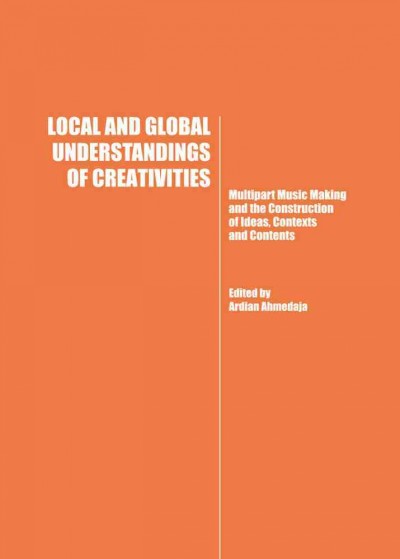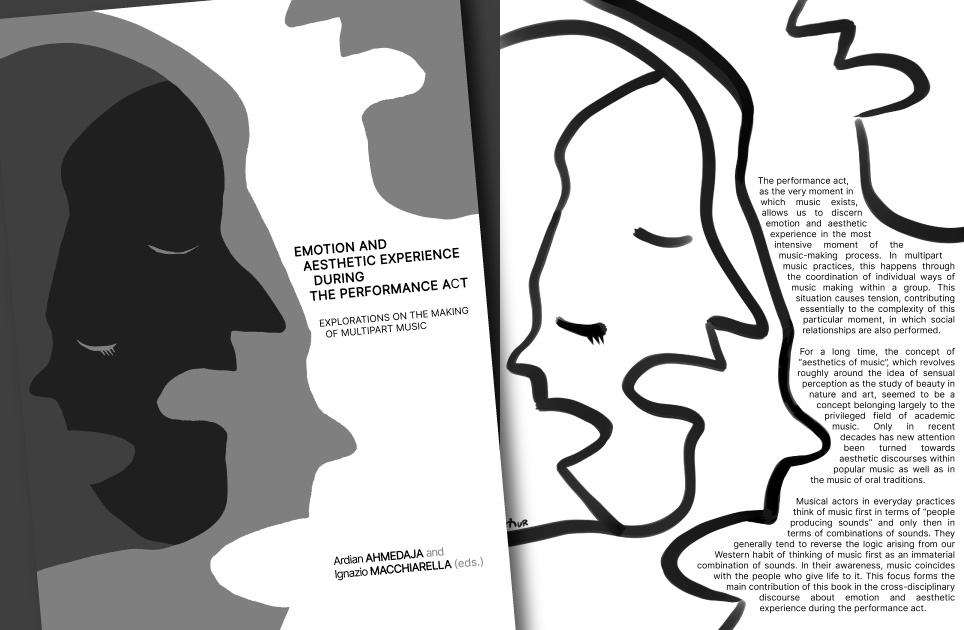
Ardian Ahmedaja (Ed.): Shaping Sounds and Values: Multipart Music as a Means of Social and Cultural Interaction. CD-ROM with 27 audiovisual examples included. A publication of the Jāzeps Vītols Latvian Academy of Music. Riga: Musica Baltica, 2021. 224 pp., 51 colour figures, list of audiovisual examples, notes on contributors, index. ISBN 978-9984-588-67-4 (hardcover).
A significant feature in the processes of shaping sounds and values in multipart music practices are the contradictions between individual and cultural perspectives. “[W]hat appear superficially as incompatibilities are seen on closer examination to be functions of different frames of reference” (Kluckhohn). In addition: “Because prevailing cultural value orientations represent ideals, aspects of culture that are incompatible with them are likely to generate tension and to elicit criticism and pressure to change” (Schwartz). In regard to music making, the “latent subversive potential” of music (Beaster-Jones) should also be considered in this context.
On the other hand, “value designates something different from being” (Dumont). Hence, the contributions in this volume employ epistemological approaches to elucidate particular ways of music making in an ontological context of multiple realities that are constantly interpreted and shaped anew during each performance act.
Pärtlas, Žanna, ed. 2016. “Multipart Music: Theoretical Approaches on the Terminology.” Special issue, Res Musica 8. (from 1st symposium in Tallinn, Estonia, 2014)
This number of the year book is dedicated entirely to this theme as it can be seen on the website:
http://www.muusikateadus.ee/
Also the first book review in this number done by Enrique Cámara de Landa is dedicated to this theme. All reviews of the number can be downloaded. We were told that this will be the case with the articles at latest in one year.At the end of each article I have add the page numbers.
News, Res Musica23. January 2017
This eighth issue of the yearbook Res Musica is the second number dedicated to the domain of ethnomusicology (the first was the 2012 edition). This time the collection of articles develops the topics discussed at the First Seminar of the ICTM (International Council for Traditional Music) Study Group on Multipart Music, held on 19–20 Septem- ber 2014 at the Estonian Academy of Music and Theatre, Tallinn. The theme of the Seminar was “Multipart Music: theoretical approaches on the terminology”.
It should be mentioned here that the form of this event was quite unusual – the number of participants was limited to eight in- vited specialists who, instead of giving standard conference papers, chaired the discussions on the related topics. This circumstance has shaped the conception of the present volume. Firstly, the clearly delimited theme of the Seminar has result- ed in the greater thematic homogeneity of the collection than usual. Secondly, the influence of the Seminar’s discussions is often apparent in the articles, leading to dialogic connections between the texts.
The editor of this yearbook is Žanna Pärtlas. Read on about its contents from Editor’s Preface.
Sisukord / Table of Contents
Saateks koostajalt 5-6 (in Estonian)
Editor’s Preface 7-8.
ARTIKLID/ARTICLES
Ignazio Macchiarella
Multipart Music as a Conceptual Tool. A Proposal. 9-25.
Mõiste multipart music kui kontseptuaalne vahend. Mõned ettepanekud (resümee) 26-27.
Ardian Ahmedaja
The Designation of Concepts in Studies of Multipart Music 28-41.
Mõistete määratlemine mitmehäälse muusika uuringutes (resümee) 42-43.
Žanna Pärtlas
Theoretical Approaches to Heterophony 44-70.
Teoreetilised lähenemised heterofooniale (resümee) 71-72.
Susanne Fürniss
What Is a Part? Polyphony between Perception and Conception 73-84.
Mis on partii? Polüfoonia taju ja kontseptsiooni vahel (resümee) 85-86.
Anda Beitāne
The Question of “Harmony” in a Local Multipart Music Practice: Eastern Latvia as a Field for Terminological Experimentation 87-97.
„Harmoonia“ küsimus kohalikus mitmehäälses muusikapraktikas: Ida-Läti terminoloogiaeksperimentide väljana (resümee) 98-99.
Ulrich Morgenstern
European Traditions of Solo Multipart Instrumental Music. Terminological Problems and Perspectives 100-114.
Mitmehäälse soolo-instrumentaalmuusika traditsioonid Euroopas. Terminoloogilised probleemid ja perspektiivid (resümee) 115.
Alessandro Bratus
Tracking Relational Spaces on Record: A Multipart Perspective on the Analysis of Recorded Popular Music 116-130.
Salvestise suhestuslike ruumide jälgel: multipart-vaatenurk levimuusika analüüsis (resümee) 131.
ARVUSTUSED/REVIEWS
Enrique Cámara de Landa 132-142.
Maurizio Agamennone (ed.). Polifonie. Procedimenti, tassonomie e forme: una riflessione “a più voci”. Venezia: il Cardo, 1996, 283 pp. (download)
Toomas Siitan 143
Peter C. Bouteneff. Arvo Pärt: Out of Silene. Yonkers (N.Y.): St Vladimir’s Seminary Press, 2015, 231 lk. (download)
Margus Pärtlas 146
Eduard Tubin – rahvushelilooja, professionaal, isiksus
Eino Tubin. Ballaad. Eduard Tubina lugu. Tallinn: Eesti Teatri- ja Muusikamuuseum, 2015, 239 lk.
Vardo Rumessen (koost.). Vestlused Eduard Tubinaga. Tallinn: Rahvusvaheline Eduard Tubina Ühing, 2015, 360 lk. (download)
Tiina Selke 148
Marju Raju. Some aspects of singing development, the song creating process and favorite songs of Estonian children / Mõningaid aspekte Eesti laste laulmise arengust, ise laulude loomisest ja lemmiklauludest. Tallinn: Estonian Academy of Music and Theatre Dissertations 6 / Eesti Muusika- ja Teatriakadeemia Väitekirjad 6, 2015, 130 lk. (download)
Anu Kõlar 151
Heli Reimann. Jazz in Soviet Estonia from 1944 to 1953: Meanings, Spaces and Paradoxes. University of Helsinki, Academic Dissertation (E-Thesis), 2015 (download)
KROONIKA (download) 156
AUTORID / AUTHORS (download) 1
Multipart Music. Individuals and Educated People in Traditional Multipart Music Practises, Proceedings of the Third Symposium of the ICTM Study Group for Multipart Music, Budapest, 2013 Edited by Pál Richter and Lujza Tari
© MTA BTK Zenetudományi Intézet, Institute of Musicology RC H HAS , Budapest, 2015 ISBN 978-963-416-016-8
Hardcover, 525 pages.
Language: English.
Price about about 40 euros (send an email to This email address is being protected from spambots. You need JavaScript enabled to view it.)

These are the proceedings of the 3rd symposium of the ICTM Study Group on Multipart Music hosted by the Institute for Musicology at the Research Centre for the Humanities of the Hungarian Academy of Sciences in Budapest (Hungary), between 12-16 September 2013. They are based on the three themes of the symposium: 1 Scholarly terminology and local musical practice; 2 The role of educated musicians and missionaries in local music practices; 3 Individualists in company (see Symposia & Seminars). The numerous acompanying audio and video examples, which originate for the most part from fieldwork recordings, give additional views on the discussed issues.
Ardian Ahmedaja, ed. Local and Global Understandings of Creativities: Multipart Music Making and the Construction of Ideas, Contexts and Contents. Cambridge: Cambridge Scholars Publishing, 2013.
Hardcover, 380 pages.
Language: English.
ISBN: 978-1-4438-4741-4.
Price: GBP 49.99.

Focusing on the ‘creators’ rather than on the ‘produced object’, the studies included in this volume explore the diversity of the roles, powers, symbolism, meanings and values given to the ‘polyphony of voices’ in secular and religious traditions based on extensive fieldwork experience. The contributors to this volume also consider the UNESCO’s Intangible Cultural Heritage List in this context, as well as the role of local, national and international awards. By understanding ‘culture as a drug’, whose absorption is realized within interacting cells, culture appears as a cellular network and music as quite an efficient device for its functioning.
Page 1 of 2


